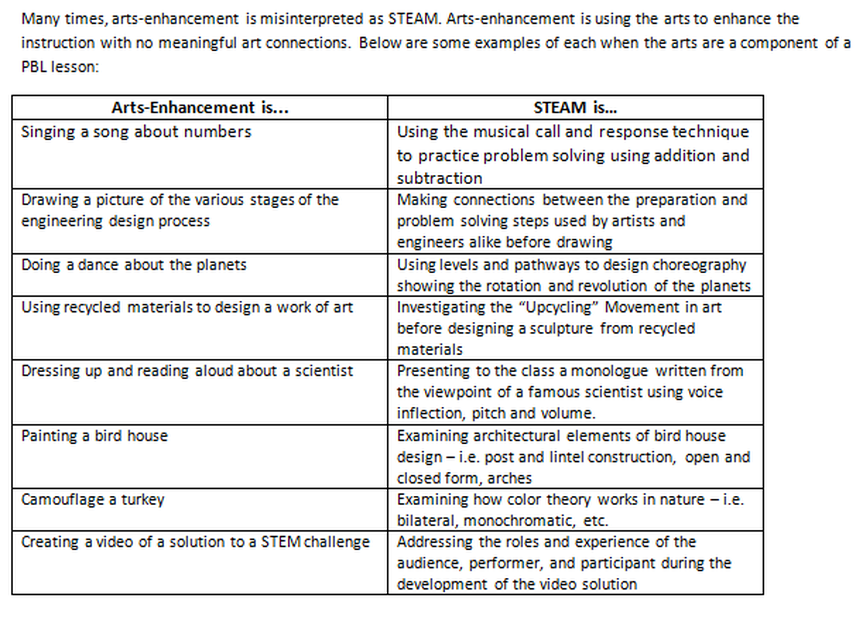What is the difference between
STEM and STEAM?
Both STEM and STEAM are dependent upon
Problem-based Learning (designing a solution to a problem).
STEM is an integration of science, technology, and/or math to design a solution to a problem. STEM challenges provide an opportunity demonstrate understanding of science and/or math standards being taught in the classroom.
STEAM is the integration of science, technology, and/or math infused with meaningful integration of the arts to design a solution to a problem. STEAM is the purposeful and intentional use the arts as a vehicle for demonstrating understanding of science and/or math standards being taught in the classroom.
True STEAM learning happens when:
-Arts standards are infused into STEM instruction
-Arts modalities are used to interpret, present and share STEM work
-The Arts are a valid assessment tool for STEM learning
STEAM v. Arts Enhancement
What are three ways to ensure I am truly designing a STEAM challenge for students?
1. Incorporate simple vocabulary from the arts into your lesson!
Examples:
STEM lesson: Students are challenged to create a marble roller coaster out of recycled materials.
Add the "A": Discuss "form and function", aesthetics and color theory in design. If a roller coaster is more visually appealing, will more people ride it? How is color selected for roller coasters? What does a designer need to think about when adding attractive elements to a roller coaster design (natural elements, metallic tones and reflective light, durable materials, etc.)
STEM lesson: Students are challenged to create a video or stage performance that teaches others about the importance of recycling.
Add the "A": Students define and take on the theatre roles of director, actor, artist, technician and writer in the process.
STEM lesson: Students are challenged to create a marble roller coaster out of recycled materials.
Add the "A": Discuss "form and function", aesthetics and color theory in design. If a roller coaster is more visually appealing, will more people ride it? How is color selected for roller coasters? What does a designer need to think about when adding attractive elements to a roller coaster design (natural elements, metallic tones and reflective light, durable materials, etc.)
STEM lesson: Students are challenged to create a video or stage performance that teaches others about the importance of recycling.
Add the "A": Students define and take on the theatre roles of director, actor, artist, technician and writer in the process.
2. Connect to the Arts Standards!
Click here to view all K-8 arts standards!
Click here to view the K-5 basic art vocabulary
Click here to view the K-5 Basic music vocabulary
Click here to view the K-5 basic theatre vocabulary
3. Connect to the Design Process!
Engineers, Scientists, Artists, Actors, Musicians, Dancers....they all use similar thinking and design processes! A STEAM lesson doesn't also have to be product driven, it can also be PROCESS driven!
Engineers, Scientists, Artists, Actors, Musicians, Dancers....they all use similar thinking and design processes! A STEAM lesson doesn't also have to be product driven, it can also be PROCESS driven!
Fine Arts & The Engineering Design Process
|
Want to expand the presentation? Click the icon with the white box and the arrows on the bottom right-hand side of the presentation viewer.
|

